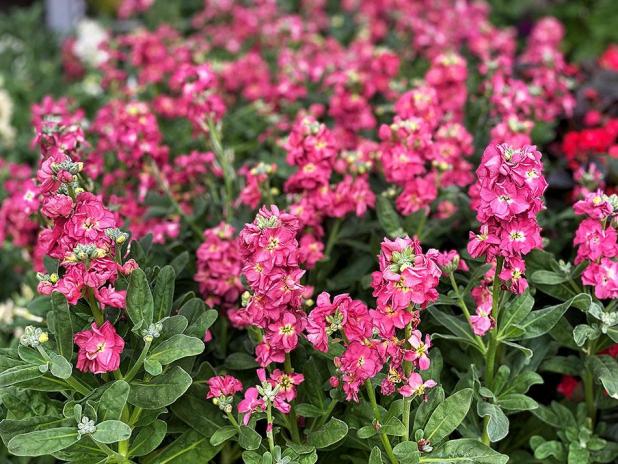
Stock is a fragrant cottage flower commonly used in flower arrangements for its gorgeous blooms and clove-like scent.
—LSU AgCenter/Heather Kirk-Ballard
Get It Growing: ‘Scentsational’ flowers for spring
The garden can rouse each of the senses. We can enjoy the beautiful colors, the sounds of wildlife, the texture of the plants, the taste of fruits, herbs and vegetables, and of course, the delightful fragrance of many flowers and plants’ foliage. Retail garden centers are beginning to fill with beautiful, fragrant spring bedding plants.
Stock flowers (Matt-hiola incana) are some of the most fragrant spring-blooming flowers grown as a bedding plant. Stock has long been used in cottage gardens and by florists for both color and their clove-like fragrance. Recorded history shows these plants were referred to as gilly flowers in England and were popular during the Victorian era. Thomas Jefferson grew them at his gardens at Monticello in the 1700s.
Stock is grown as an annual in Louisiana and performs best in full to partial sun in a rich, well-drained soil. Plants grow 12 to 36 inches in height and have an upright growth habit. Flowers are tightly clustered on tall stems and come in colors of white, purple and pink. It pairs well with other flowers with similar needs such as alyssum, dianthus, nemesia, petunias, snapdragons and violas.
Because stock prefers cooler temperatures, flower production will last longer if planted in areas that receive morning sun to reduce exposure to the hot, bright sunlight of the afternoon. Remove faded flowers to promote new growth. Flowers are edible and have a delicate taste. They are a beautiful addition to salads and great as cake and dessert decorations.
Nemesia (Nemesia spp.) is another excellent spring bedding plant to bring fragrance to the garden, and it pairs well with stock. With more of a spreading, mounding habit, it grows well in both containers and in landscape beds with taller, upright plants, including snapdragons and dianthus. Nemesia offers almost every color imaginable and many bicolor blooms as well.
Nemesia prefers well-drained soil and can be susceptible to root rot. For the best flower production, grow nemesias in full sun. Plants will last longer into the summer in an area that gets morning sun and is shaded in the afternoon. Giving them a little afternoon shade can also help extend their blooms a little longer, as they do tend to go out of flower once night temperatures are consistently above 70 degrees, causing them to become leggy. You can trim and shape plants to encourage new growth and flowers and fertilize with a liquid feeding after trimming.
Another excellent, fragrant flower is alyssum, also known as sweet alyssum. This plant, like nemesia, has a trailing growth habit with a shorter height of 3 to 6 inches, making it a great selection to use as a border plant, in containers as a “spiller” and in hanging baskets. In addition to having a great fragrance and prolific blooms, alyssum is a drought-tolerant option for the landscape. Flowers are produced in tiny clusters in a mounding habit coming in colors of pink, purple and white. Plants bloom more in full sun but also perform well in partial shade.
All three selections are highly fragrant with delicate color and have few pests or disease problems. All three prefer well-drained, rich soils. Deadhead flowers to encourage new flower growth, and be sure to supplement rainwater with irrigation in extended periods of drought and as temperatures heat up.
I will end this column with a quote from film director Louis Schw-artzberg: “Always take time to smell the flowers, and let it fill you with beauty and rediscover that sense of wonder.”
